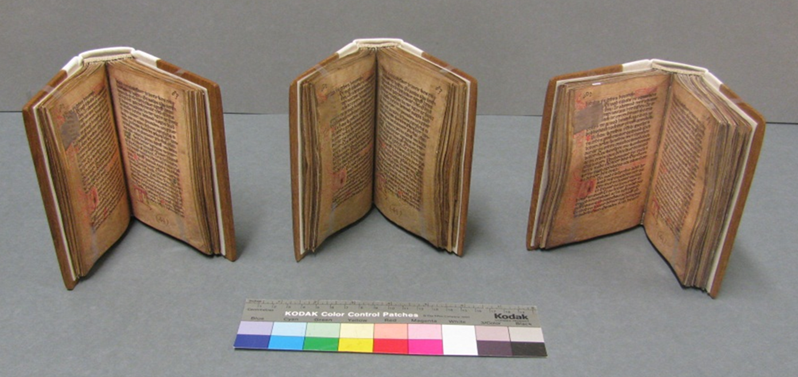Sally McInnes is Head of Unique Collections and Collections Care at the National Library of Wales.
When Sarah Middleton announced that the theme of this year’s World Digital Preservation Day was Digits: for Good, I could not resist the chance to talk about the Library’s approach to preserving one of Wales’s most iconic manuscripts, namely the Boston Manuscript of the Laws of Hywel Dda (the Good). The Library has combined innovative approaches in traditional conservation, digitisation and digital preservation to ensure that these Welsh Laws are accessible now and in the future.
The Boston Manuscript was purchased in 2012 by the Library with assistance from the Lottery Heritage Fund, the Friends of the National Libraries and the Welsh Government. The manuscript, written in Welsh, dates from around 1350 and records the native Welsh laws, which were thought to have been codified by Hywel Dda. It is a key text in the history of Welsh law and provides insights into Welsh identify and cultural life. It was used as a working text, being annotated by a Judge in South Wales, who carried it around in his pocket. By the 19th century, the manuscript had reached America and was in the custody of the Massachusetts Historical Society in Boston, having probably been taken across the Atlantic by an emigrant.
A conservation assessment revealed that the manuscript was very fragile, with many tears and splits, meaning that it could not be handled without the risk of further damage. The decision was taken to dis-bind the volume and digitise the content, which would enable the re-binding of the original, the creation of facsimile copies and digital access.
A complex workflow has been developed to manage the digitisation process from selection to access and storage. A Benchmarking exercise ensured that the manuscript was digitised according to the standards and methodologies established for digitising manuscript materials. The protocols for scanning were specified, including the essential information to capture, file name attribution, conversion process and the file formats specification for master and derivative files.

The scanning process was facilitated through the dis-binding, enabling each folio to be captured in entirety, without the need to de-warp. This assisted with the process of digitally extending the outside edges of the parchment. Each flattened folio could be scanned through the use of a line scanning system, rather than the usual method of using a single-shot camera and cradle. Through the use of this method, the images could be captured at a higher resolution than usual practice allowed and there was greater consistency in lighting and enhanced colour accuracy.
The scanning process generated TIFF master files, with the JP2 derivatives being generated on ingest to Fedora, the Digital Asset Management System. The METS files, which included descriptive and structural metadata were also generated on ingest. The master TIFF files were stored in the Digital Archive. Preservation actions, including checksum verification, fixity monitoring and preservation planning ensure the preservation of the digital content.
Another benefit of the disbanding and scanning process was the ability for the Library to demonstrate its pioneering techniques in creating facsimiles, which are almost indistinguishable from the originals. Printed copies of the scanned leaves, on high quality archival paper, were joined together and pasted back to back to form folios and gatherings. This back to back format ensured that the facsimile would be the same thickness as the original manuscript. The innovative technique of emulating parchment through manually stretching the paper unevenly, whilst the leaves were still damp, resulted in an authentic cockled appearance.
The facsimiles were bound in the same way as the original and have been used for teaching and outreach purposes, allowing extended access to the manuscript, whilst safeguarding the original.

Spot the difference!
The digitised manuscript can be viewed on the Library’s website. The images are served up through a IIIF manifest, linked to the derivative files held in Fedora, which supplies the Universal Viewer. The images can be manipulated, with the ability to zoom in on parts of the manuscript, turn the pages and have a variety of views. The descriptive metadata is available with the images to provide contextual information.
The purpose of this year’s World Digital Preservation Day is to reflect the positive aspects of preserving and providing access to digital content, at a time when there has been a particular focus on the global reliance on digital information. Through its approach to preserving and extending access to one of Wales’s most significant treasures, the Library has certainly used its digits, both figuratively and literally, for good and for all.
